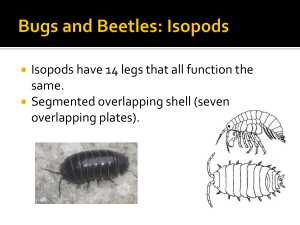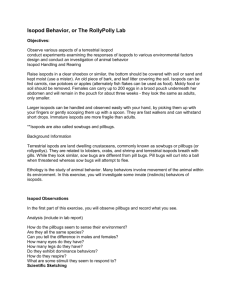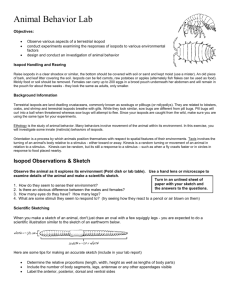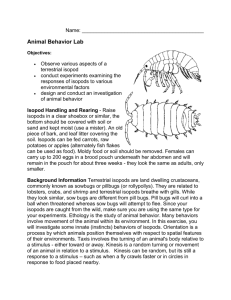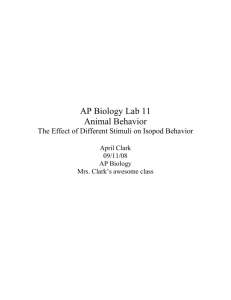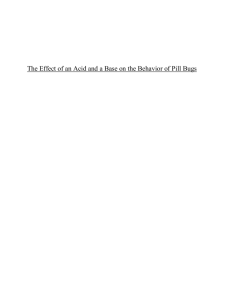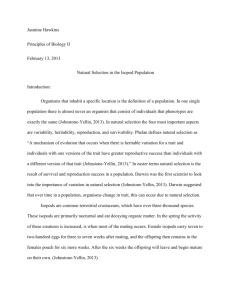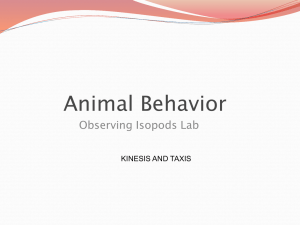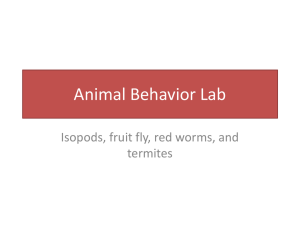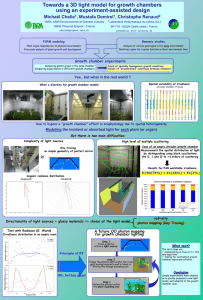AP Biology Lab 11
advertisement
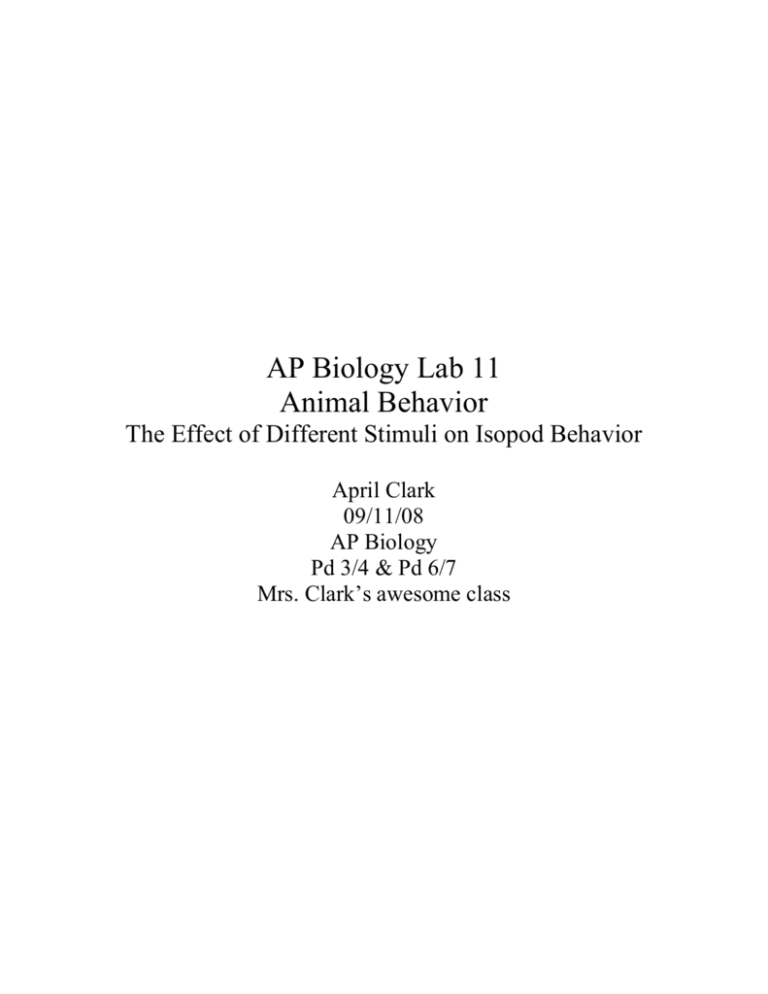
AP Biology Lab 11 Animal Behavior The Effect of Different Stimuli on Isopod Behavior April Clark 09/11/08 AP Biology Pd 3/4 & Pd 6/7 Mrs. Clark’s awesome class Purpose: There were three main purposes for this investigation. First, isopods were observed so behavior and structures could be recorded. Then the isopods were exposed to two different scenarios, wet vs. dry and acidic vs. neutral, to determine which environment they preferred. Background: Ethology is the study of animal behavior. An animal’s behavior is its response to sensory input. There are three types of behaviors: orientation, agonistic, and mating. Orientation behaviors take the animal to its most favorable environment. Taxis is then an animal moves toward or away from a stimulus. Taxis is often observed in response to changes in light, heat, moisture, sound, or chemicals. Kinesis is random movement and doesn’t involve stimuli. Agnostic behavior is when animals respond to each other in aggressive or submissive movements. An example would be when the hair on a dog’s back stands up when it is being aggressive. Mating behaviors are activities that involve finding, courting, and mating with a member of the same species. An example would be a peacock fluffing up its feathers to attract females. To observe animal behavior in this lab, isopods will be isolated in a controlled experiment. Terrestrial isopods are more commonly known as pill bugs, rolly pollies, potato bugs, or sow bugs. They are crustaceans with a hard exoskeleton, seven pairs of legs, and antenna. Isopods are related to lobsters, crabs, and crayfish. Some roll up into a ball when disturbed, while others crawl away quickly. They generally eat decaying wood, leaves, and other vegetation. Isopods breathe with gills, so they are restricted to areas with high humidity, under rocks or logs, in leaf litter or in crevices. They prefer darkness as well. Figure 1 Hypothesis: When isopods are exposed to wet and dry conditions, they will prefer to stay in the wet environment because they are used to living in dark, moist conditions. When isopods are exposed to acidic and neutral conditions, they will prefer the acidic conditions because they are usually found in soil and the soil in this area is slightly acidic. Materials: The following materials were used in this experiment: pill bugs (isopods), Petri dish, connected chamber, water, pipette, filter paper, timer, magnifier, paint brush, dilute hydrochloric acid. Procedure: 1. Place isopods in a Petri dish and observe them for 10 minutes. Handle the isopods with only a paint brush. Record any observations that are characteristic to the bugs. Sketch a drawing of one isopod. 2. Place filter paper on both sides of connected chamber. Add water to one side of the chamber until the filter paper is damp. Add the isopods to the chambers. Observe how many isopods are in each chamber. Record the number of isopods that are in each chamber every 30 seconds for 10 minutes. 3. Place filter paper on both side of the connected chamber. Add 1% hydrochloric acid to one side of the chamber until the filter paper is damp. Add the isopods to the chambers. Observe how many isopods are in each chamber. Record the number of isopods that are in each chamber every 30 seconds for 10 minutes. Data/Observations: 1. General observations: a. Larger isopods climb over smaller ones b. Move fast c. Tend to move as a group d. Movement around edges e. Use antenna to sense edge and other isopods f. When flipped over will either play dead, roll up, or kick off from ground to turn over g. See attached drawing of isopod 2. Time (minutes) 0 0.5 1.0 1.5 2.0 2.5 3.0 3.5 4.0 4.5 5.0 5.5 6.0 6.5 7.0 7.5 8.0 8.5 9.0 9.5 10.0 Table 1 - Isopod taxis in wet vs. dry Number of isopods Number of isopods Observations in wet chamber in dry chamber 5 5 9 1 Climbing on top of each other 8 2 8 2 9 1 10 0 4 in one pile along edge 9 1 7 3 9 1 9 1 8 2 7 3 9 1 7 3 7 3 Movement slowed down 7 3 8 2 9 1 Large sitting groups 7 3 Little movement 8 2 9 1 Average isopod number in wet chamber = 8 Average isopod number in dry chamber = 2 See attached graph. 3. Time (minutes) 0 0.5 1.0 1.5 2.0 2.5 3.0 3.5 4.0 4.5 5.0 5.5 6.0 6.5 7.0 7.5 8.0 8.5 9.0 9.5 10.0 Table 2 - Isopod taxis in acid vs. neutral Number of isopods Number of isopods Observations in neutral chamber in acidic chamber 5 5 7 3 6 4 Backing away from acid 4 6 5 5 More movement on acid 3 7 3 7 2 8 3 7 Clustering into group 4 6 4 6 1 9 3 7 2 8 1 9 0 10 1 9 Less active 0 10 0 10 0 10 Little movement 0 10 Average number of isopods in neutral conditions = 4.1 Average number of isopods in acidic conditions = 5.9 See attached graph. Analysis/Discussion: In this investigation there were several variables. The independent variables were the different conditions in the chambers. For the first experiment, the independent variables were the wet and dry conditions. In the second experiment, the independent variables were the acidic and neutral conditions. For both experiments, the dependent variable was the isopod behavior. The main control for this experiment was the initial observation. The kinesis observed at this time was used to determine if the isopod behavior in the two experiments was truly taxis behavior in response to the different conditions. Other controls include using the same amount of bugs, using a timer, using the same chamber, and using similar textures in the chambers. In the first experiment, the isopods preferred the wet conditions. This is probably because this is closer to their natural habitat. Isopods use gills, so they need moist conditions to survive. In the second experiment, the isopods preferred the acidic conditions over the neutral conditions. This is probably due to the fact that they live in soil and under logs, which are acidic conditions. They must need this type of environment to maintain homeostasis. In the first experiment, other groups in the class got various results. This could have been due to different wet conditions. The isopods may avoid an area if it is too wet and this would skew the results. The class didn’t compare data from the second experiment. Isopods locate appropriate environments by using their antennae. They used their antennae at all times while mobilizing around the chambers. They must rely on antennae over eye-sight. If you suddenly overturned a rock and found isopods, the expected behavior would be for them to move around quickly. Eventually, the movement may slow down. It is likely that they would continue to move until they found another moist, dark environment. I would classify the isopods movement in response to a wet environment as taxis. They eventually slowed down their movement, with most settling on the wet side. Since the classroom data wasn’t consistent during the wet and dry experiment, a larger sample size is probably needed. The larger the sample size, the more likely the data will represent true isopod behavior. In addition to sample size, the isopods could be observed for longer periods of time to get more accurate data. Conclusion: In this investigation the behaviors of isopods were observed and investigated. The isopods preferred the wet environment because their normal habitat is moist. My hypothesis was proven correct. In the acid vs. neutral experiment, it was observed that the isopods preferred the acid conditions. Most soils in forested areas are acidic. Again the isopods chose the environment that was closest to their natural habitat. The hypothesis stated was correct. References:
